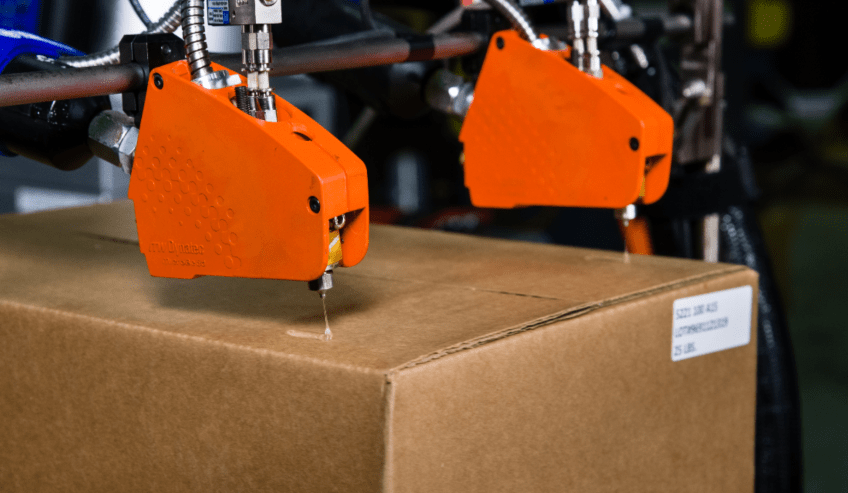
胶水话题博客

2019年工作场所死亡人数达到5333人,比2018年增加了2%。可预防的非致命工作场所伤害数量则高得多。为了防止工作场所的伤害,实施安全协议并遵循工作场所安全的最佳实践对于企业的成功、工人的安全以及持续推动更安全的工作条件至关重要。热熔胶粘剂也不例外,需要特别注意以安全操作。
热熔胶粘剂安全性和可持续性的发展
热熔胶粘剂的化学成分包括聚合物、增塑剂、增粘树脂和抗氧化剂,每一种成分都调整产品的特性,以确保在不同温度和操作条件下具有高粘合强度。
聚合物是作为粘合框架的核心成分。增塑剂会影响粘度。增粘树脂通过性能属性增强粘合剂的牢固性。抗氧化剂则影响热熔胶在高温下长时间保持化学成分完整性的能力。
随着热熔胶粘剂的新发展,这些产品应能提高制造效率和使用热熔胶粘剂所创造产品的价值。这为这些产品在应用中满足新的安全和可持续性法规打开了大门。
化学成分的进步使热熔产品能够在各种温度下抵御粘合失效,兼容各种基材,减少废料,减少生产停机时间,并在使用量上获得更高的效益。对可持续性的日益关注也提高了热熔胶粘剂在产品本身和使用过程中的环保性和安全性。
热熔胶粘剂的使用
热熔胶粘剂最常用于包装密封和书籍装订,需要特别注意以避免严重烫伤,这会导致生产线减速和受伤工人的停工。
虽然热熔胶粘剂作为原始未加热的热塑性塑料时是无害的,但要使其功能化,需要加热到很高的温度以将材料转变为熔融状态,通常在350华氏度下应用。因此,工人需要格外小心并遵循严格的指导方针以安全操作热熔产品。为确保操作员安全,整条生产线必须致力于热熔安全实践和风险管理。
采取预防措施
个人防护装备(PPE)至少应包括有侧护的护目镜和耐高温的手套。除PPE外,安全数据表(所有热熔产品均附有)还详细说明了在安全设备方面的要求,以帮助工人在最佳防护条件下工作。
促进理想热熔安全条件的一个重要步骤是定期维护工人用于应用热熔产品的设备。从软管和输送系统的维护到温度的一致性,设备的监控和维护应定期进行。
热熔材料的罐应填充到容量的四分之三,以确保热熔机的最佳性能并达到适当的应用温度。为减少风险,应使用铲斗填充罐,以避免污染、减少飞溅和防止溢出。任何洒在地上的颗粒或原始热熔材料应立即清理并丢弃,以防止工人滑倒和避免污染。自动填充系统是防止溢出和保持罐内清洁的好方法,同时还能保持黏合剂水平,使操作员有更多时间进行生产线上的其他任务。热熔设备的软管也不应接触地面,以防止热沉并延长软管的使用寿命。
维护、性能和安全
炭化是可以避免的危害,会降低设备性能效率、浪费产品,并因不理想的条件导致生产力下降。燃烧的有机材料(炭化物)会开始凝胶,粘附在罐和软管的壁上,随着时间的推移降解系统。炭化物还会改变热熔材料的粘度特性,影响一致性。
清除设备中的炭化物大大提高了热熔材料通过应用设备的效率。在停机时间内清除热熔设备中的炭化物效果最佳,同时黏合剂冷却,以避免生产时间损失,并消除机器正常使用时的干扰。所有维护工作都旨在限制因设备故障引起的工作场所危险,并提高工人使用时热熔材料的性能。
紧急情况下的应对措施
应用过程和维护的一致性有助于确保热熔材料和设备的最佳功能,并保持工人的安全。但如果发生安全事故,一些基本的预防措施将有所帮助。
任何与皮肤表面接触的熔融热熔材料应迅速处理。不要试图擦掉受影响区域的热熔材料。相反,应在受影响的皮肤表面上冲凉水,并用凉敷料包裹,并立即就医。使用前应查阅安全数据表,以了解所有必要的个人防护装备和预防措施。
为了增加安全性和生产力,适当的警告和防护措施,以及在生产线运行时利用热熔设备待机措施,可以减少工人接触潜在烧伤的机会,并减少炭化和设备故障的风险。采取正确的措施,可以快速调整热熔材料的温度,使工人能够及时处理紧急情况,并确保生产线的正常运行时间。
向我们学习
在H.B. Fuller,我们拥有满足安全和可持续性标准的热熔胶粘剂的专业知识和最新技术。更多信息请访问我们的H.B. Fuller Academy
Blog Categories
Blog Categories
Archive
- 2025
- 2024
- 2023
- 2022
- 2021
